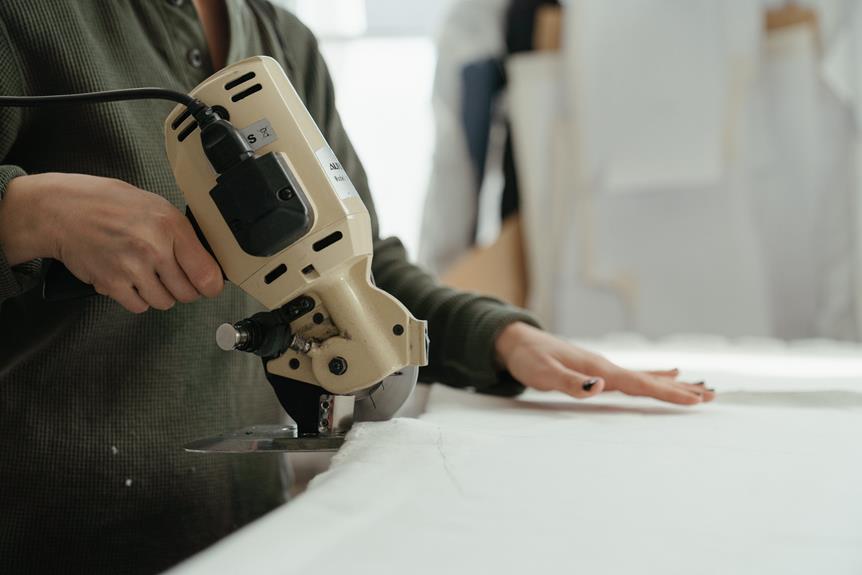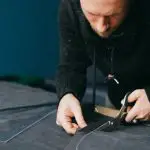When choosing the best rotary cutter for fabrics, you want to consider:
- Blade size
- Handle design
- Safety features
- Cutting efficiency
- Durability
- Budget
Each of these aspects plays a crucial role in achieving precise and effortless fabric cutting.
By understanding the different types of rotary cutters and their specific features, you can make an informed decision that aligns with your skills and needs.
Let's explore the key factors to help you select the perfect rotary cutter for your fabric projects.
Key Takeaways
- Blade size, handle design, and safety features are important factors to consider when choosing a rotary cutter for fabrics.
- The type of blade material, such as titanium-coated or high-carbon steel, should be considered for its sharpness and fabric compatibility.
- Blade size and material should be chosen based on cutting capacity, sharpness, material compatibility, and ergonomic design for efficient and precise cutting.
- Handle design should focus on an ergonomic grip, minimizing hand fatigue, and providing accessible blade maintenance for a comfortable and secure cutting experience.
Types of Rotary Cutters
Choose the rotary cutter that best suits your fabric-cutting needs.
When it comes to cutting techniques, different rotary cutters offer varying features to cater to your specific requirements.
Firstly, consider blade sharpness. Some cutters have titanium-coated blades that are incredibly sharp and durable, ensuring clean and precise cuts. These are ideal for thick or multiple layers of fabric. On the other hand, if you mainly work with delicate or thin fabrics, a rotary cutter with a high-carbon steel blade might be more suitable.
Next, think about fabric compatibility. Certain rotary cutters are designed to handle specific types of fabric more efficiently. For instance, if you primarily work with intricate patterns and curves, a smaller cutter with a 28mm blade could provide better maneuverability.
Maintenance tips are also crucial. Look for rotary cutters that are easy to disassemble for thorough cleaning and blade replacement. Some models even come with a blade-changing tool for added convenience. Prioritize finding a cutter that meets your needs while also being easy to maintain.
Blade Size and Material
When selecting a rotary cutter for fabric, consider the blade size and material that will best suit your cutting needs. The blade size and material play a crucial role in determining the efficiency and precision of your cutting process.
- Cutting Capacity: The blade size directly impacts the cutting capacity of the rotary cutter. Larger blades are ideal for cutting through multiple layers of fabric, while smaller blades are suitable for intricate and detailed cuts.
- Blade Sharpness: The material of the blade influences its sharpness and durability. High-quality steel blades retain their sharpness for longer periods, ensuring clean and precise cuts without fraying the fabric edges.
- Material Compatibility: Different blade materials are suitable for specific fabric types. Ensure that the rotary cutter's blade material is compatible with the fabrics you primarily work with to achieve optimal cutting results.
- Ergonomic Design: Consider the ergonomic design of the rotary cutter, including the handle and overall comfort during extended use. A comfortable grip and a well-balanced design can significantly reduce hand fatigue and enhance cutting accuracy.
When selecting a rotary cutter, prioritize blade size, material compatibility, and ergonomic design to ensure efficient and precise fabric cutting.
Handle Design and Comfort
Curiously, do you find yourself comfortable and secure in your grip of the rotary cutter as you make prolonged cuts through fabric? The handle design and comfort of a rotary cutter are crucial for a smooth cutting experience. An ergonomic grip is essential to minimize hand fatigue and ensure precise cuts. When selecting a rotary cutter, consider the handle design and how it feels in your hand. Look for options with cushioned grips or contoured handles that fit comfortably in your palm, allowing you to maintain control without straining your hand.
To aid in your decision-making process, here is a comparison table highlighting key features related to handle design and comfort, as well as blade changing and maintenance tips:
| Feature | Description |
|---|---|
| Ergonomic Grip | Look for cushioned or contoured handles for comfortable use |
| Hand Fatigue | Consider handle designs that minimize strain on your hand |
| Blade Changing | Check for easy and safe blade replacement mechanisms |
| Maintenance Tips | Look for rotary cutters with accessible blade maintenance |
Considering these features will help you find a rotary cutter that not only provides a comfortable grip but also offers convenient blade changing and maintenance options.
Safety Features to Consider
Ensuring the safety of your cutting experience requires careful consideration of the built-in safety features of a rotary cutter. When choosing a rotary cutter, look for certain safety features that can make your cutting experience more secure and comfortable.
Here are four essential safety features to consider:
- Ergonomic Grip: Look for a rotary cutter with an ergonomic grip that fits comfortably in your hand. An ergonomic grip can help reduce hand fatigue and provide better control, leading to a safer cutting experience.
- Blade Guard: A rotary cutter with a blade guard adds an extra layer of protection. The blade guard covers the blade when not in use, minimizing the risk of accidental cuts and ensuring safe storage.
- Blade Locking Mechanism: Opt for a rotary cutter with a reliable blade locking mechanism. This feature keeps the blade securely in place during use, preventing it from accidentally slipping out and causing injuries.
- Safety Trigger: Some rotary cutters come with a safety trigger that needs to be engaged before the blade can be exposed. This added safety measure can prevent accidental blade exposure, reducing the risk of injuries.
Cutting Efficiency and Precision
To achieve precise cuts with maximum efficiency, your fabric's rotary cutter blade should be sharp and well-maintained. Cutting techniques play a pivotal role in the longevity of your fabric.
When using a rotary cutter, ensure that the blade is sharp to effortlessly glide through the fabric, preventing fraying and ensuring clean edges. Additionally, employing proper cutting techniques such as applying consistent pressure and using smooth, continuous motions can significantly enhance the precision of your cuts and contribute to the fabric's longevity.
Blade sharpness is crucial for cutting efficiency and precision. A sharp blade minimizes the risk of the fabric shifting or bunching during cutting, allowing for smooth, accurate cuts. It's essential to regularly replace blades to maintain their sharpness, especially when working with materials of varying thickness and compatibility. Different fabrics may require different blade types and sharpness levels for optimal results, so consider the material compatibility when selecting and maintaining your rotary cutter blades.
Durability and Maintenance
You'll want to consider the blade lifespan and care as well as long-term usability tips when choosing a rotary cutter for fabrics.
Proper maintenance and care play a crucial role in ensuring the durability of your rotary cutter. By implementing these tips, you can extend the lifespan of your cutter and maintain its efficiency over time.
Blade Lifespan and Care
Maintain your rotary cutter blade by regularly cleaning and oiling it to ensure durability and longevity.
- Blade sharpening:
Regularly sharpen the blade to maintain its cutting efficiency. Use a rotary blade sharpener for precise and safe sharpening.
- Maintenance:
Inspect the blade regularly for any signs of wear and tear. Replace the blade if you notice nicks, dents, or loss of sharpness.
- Cutting mat:
Always use a self-healing cutting mat to protect the blade and ensure clean cuts. Store the mat flat to prevent warping.
- Storage requirements:
When not in use, store the rotary cutter in a safe place, away from moisture and direct sunlight. This will prevent rusting and maintain the blade's sharpness.
Long-Term Usability Tips
For ensuring long-term usability, regularly oil and clean your rotary cutter blade to maintain its durability and cutting efficiency. Long term maintenance is crucial to preserve blade sharpness and ensure smooth cutting. Additionally, consider the comfort and ergonomics of your cutter for extended use. A comfortable grip and ergonomic design can reduce hand fatigue and strain, making it easier to work on larger projects for longer periods. To help you make an informed decision, below is a comparison table of some popular rotary cutters:
| Feature | Rotary Cutter A | Rotary Cutter B | Rotary Cutter C | Rotary Cutter D | Rotary Cutter E |
|---|---|---|---|---|---|
| Blade Material | Titanium | Stainless Steel | Ceramic | Tungsten Steel | High Carbon Steel |
| Handle Design | Ergonomic | Non-slip Grip | Contoured | Cushioned | Textured Grip |
| Blade Replacement | Tool-Free | Screw-On | Snap-Off | Screw-On | Tool-Free |
| Safety Mechanism | Button Lock | Trigger Guard | Safety Lock | Manual Cover | Button Lock |
| Price | $ | $$ | $$ | $$$ | $ |
Budget-Friendly Options
Looking to save money without sacrificing quality? When it comes to budget-friendly rotary cutters for fabrics, there are several options that offer great value without compromising performance. Consider these factors to make a cost-effective choice:
- Versatile Blades: Opt for a rotary cutter that supports various cutting techniques and is compatible with different fabric types. This versatility allows you to use the same cutter for multiple projects, saving you from the need to purchase different tools for different materials.
- Sharpness and Durability: Look for a cutter with durable, sharp blades that maintain their edge over time. Additionally, check if the blades are easily replaceable to avoid having to purchase an entirely new cutter when the blades become dull.
- Comfort and Control: Choose a rotary cutter that offers ergonomic handles for comfortable use and precise control. This ensures that you can work on your projects for extended periods without discomfort, while also achieving accurate cuts.
- Affordable Replacement Blades: Consider the availability and cost of replacement blades for the cutter. Opt for a model that offers affordable replacement options, allowing you to maintain the cutter's effectiveness without breaking the bank.
Frequently Asked Questions
Can Rotary Cutters Be Used on All Types of Fabrics, Including Delicate or Stretchy Materials?
When using rotary cutters on fabrics, it's important to consider their compatibility with different materials. Cutting techniques and safety precautions are crucial for delicate or stretchy fabrics. Regular maintenance ensures optimal performance and longevity.
Are There Any Specific Rotary Cutters That Are Best Suited for Left-Handed Individuals?
When looking for the best rotary cutters for left-handed individuals, consider models with ambidextrous designs or ones specifically made for lefties. Using a left-handed rotary cutter can enhance comfort and precision for smoother, more efficient fabric cutting.
What Should I Consider When Choosing a Rotary Cutter for Quilting Projects?
When choosing a rotary cutter for quilting, consider blade size and handle comfort. The blade size should suit the fabric thickness and intricacy of cuts. A comfortable handle ensures precise cutting without hand strain.
Are There Any Rotary Cutters That Are Designed to Reduce Hand Fatigue During Long Cutting Sessions?
To reduce hand fatigue during long cutting sessions, look for rotary cutters with ergonomic design. Some brands offer specialized options for left-handed users. These features can enhance comfort and precision, making quilting and fabric cutting more enjoyable.
Can Rotary Cutters Be Used for More Intricate and Detailed Cutting, Such as Curves and Intricate Patterns?
Yes, rotary cutters can be used for precision cutting and intricate designs, making them suitable for cutting curves and detailed patterns. Their sharp blades and maneuverability allow for accurate and detailed fabric cutting.
- How Does Ring Spun Cotton Affect Garment Fit and Shape Retention? - August 13, 2024
- What Are the Challenges in Producing Ring Spun Cotton? - August 13, 2024
- Is Ring Spun Cotton Suitable for Plus-Size Clothing? - August 13, 2024






